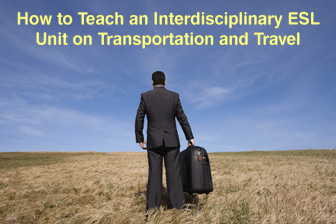ESL students, if they are studying in the United States, almost all have experience with travel.
Whether for that reason or because travel is a hobby for many, travel units are very common among ESL curriculums. It is easy to take the idea of travel and apply it to the different language classes you may be teaching. Here are some suggestions on how you can do it.

Teaching an Interdisciplinary ESL Unit on Transportation and Travel
-
1
Speaking
Most of the time when a person travels, she ends up staying in a hotel. Your students can practice the interaction between a hotel guest and a hotel clerk with a simple role play. One student should sit at a desk and ask the other student for information. She will be looking for information on the length of stay, how many beds are needed for the number of guests and any special accommodations the person needs. The hotel guest will also have to give the clerk her full name, address, phone number and payment information. When pairs of students have practiced the role play, have them trade parts and do it again. During the role play, encourage your students to use any or all of the following phrases:
- May I help you?
- Do you have a reservation?
- Do you have any vacancies?
- Have a pleasant stay.
- How will you be paying?
- How long will you be staying?
- Here is your key card.
- Your room is located …
- Would you please sign here? -
2
Writing
Part of travelling is seeing the sights an area has to offer. If a traveler does not plan, though, he may miss out on a big attraction because the location is not open on a certain day, because he spends too much time on another sight, or because he does not plan how to get to the attraction. In this exercise, your students will write a travel itinerary for a tourist destination. Have each student choose a location to look at, either a place he has been or a place he would like to go, and plan a trip to that area. Tell your students to choose a location that has tourist attractions or other places of interest rather than something like going to a beach. Approve your students’ choices, and then have them plan an itinerary for a weeklong visit. Make sure your students look into the public transportation available in that city, and if there is none locate a car rental office they would be able to use. For each location, your students should note how to get to the location from where they will stay and how long they plan to be there. The information could be put into chart format, which may challenge your students to write concisely and clearly.
-
3
Reading
If you can collect several travel brochures, they will come in handy for this exercise. A travel agent might be a great resource for getting some of these, or grab them any time you visit a new place and keep a running collection to use in class. If you do not have time to gather actual brochures, you can use the internet as a resource for your class. Have your students choose a brochure or a set of brochures about one city. Give them time to look over and read the brochures, and ask them to make observations on the style of writing in the brochures. Small groups are a good venue for this. Challenge your students to share how the writing in the brochure is different from that in more traditional texts you have probably used in class. Is the brochure informative? Does it appeal more to emotion than to logic? Is the writing meant to be persuasive or simply informative? Does it rely more on pictures or more on text? Which is better? Once your students have fully discussed the brochures, have the small groups write 5 rules that a writer should follow when putting together a travel brochure. If you like, have your students write their own travel brochures that advertise a location in their home countries!
-
4
Listening
For a challenging listening exercise using British English, show your students this video from the BBC on travel ads that are too good to be true. The eight minute video discusses why some advertised travel packages are not what they appear to be and what consumers can do about it. To use this clip in class, play the video once for your student to get the feel of the speaking and information presented. Then, ask your students to listen again and see if they can note three different types of information: why these advertisements are too good to be true, how the industry is being regulated, and advice to consumers. You may want to pause the video after each section and discuss it with your students if they are having trouble. Play the video a third time and let your students check their notes, and then have them discuss their answers in groups of three or four students. After the groups, you may want to show the video one more time and then discuss it as a class.
Whether your students are thinking about travelling or just recovering from a recent trip, talking about travel in the ESL classroom will give them useful, practical English skills that can be used in real life.
You and your students may learn about a travel destination that you just cannot keep away from and you’ll be planning a trip before you know it. Where do your students think are the best places to visit while studying English?
P.S. If you enjoyed this article, please help spread it by clicking one of those sharing buttons below. And if you are interested in more, you should follow our Facebook page where we share more about creative, non-boring ways to teach English.







